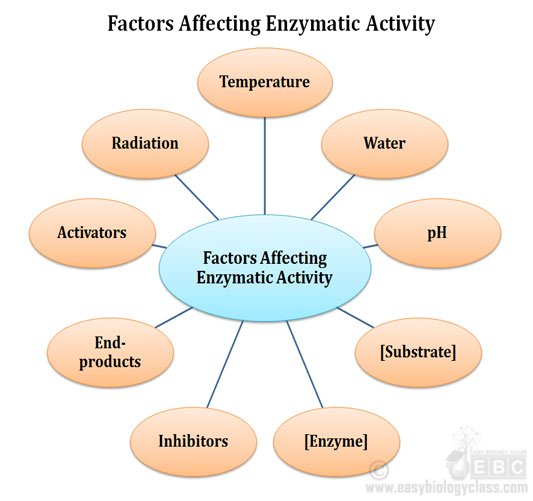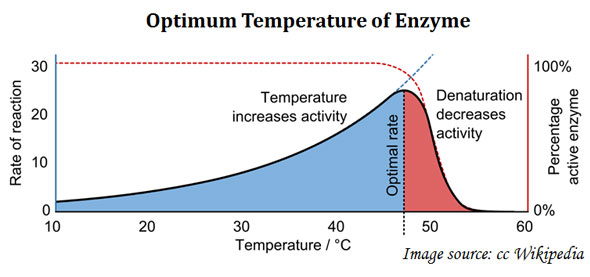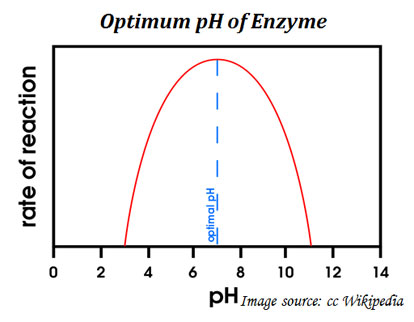In the previous post, we have discussed the Properties of Enzymes. In the present post, we will see what all are the factors that affect the catalytic activity of an enzyme in the living system.
Factors Affecting Enzymatic Activity
Ø The catalytic activities of enzymes are affected by multiple factors. They can be summarized as:
 (1). Temperature
(1). Temperature
(2). Water
(3). Hydrogen ion Concentration (pH)
(4). Concentration of Substrate
(5). Concentration of Enzyme
(6). Inhibitors
(7). Accumulation of End-products
(8). Effect of activators
(9). Effect of light and radiation
(1). Temperature
Ø The enzymatic activity will be optimum at normal temperature.
Ø At very low temperature the activity of enzyme will be minimal or zero.
Ø The increase in temperature (up to a certain limit) can increase the enzyme’s catalytic activity. (Study the graph below).

Ø The maximum activity is observed between 30 to 45ºC for most of the enzymes.
Ø Beyond 45ºC the enzyme activity is reduced drastically.
| You may also like NOTES in... | ||
|---|---|---|
| BOTANY | BIOCHEMISTRY | MOL. BIOLOGY |
| ZOOLOGY | MICROBIOLOGY | BIOSTATISTICS |
| ECOLOGY | IMMUNOLOGY | BIOTECHNOLOGY |
| GENETICS | EMBRYOLOGY | PHYSIOLOGY |
| EVOLUTION | BIOPHYSICS | BIOINFORMATICS |
Ø Beyond 60-70ºC the enzymes were denatured.
Ø Temperature coefficient or Q10: Increase in the velocity of enzymatic reactions when the temperature is increased by 10°C.
Ø The Q10 of majority of enzymes will be 2 at a temperature between 0 and 40°C.
(2). Water
Ø Enzyme activity is suppressed in the absence of water.
Ø In dry seeds, the enzymes are almost inactive.
Ø Hydration of the cells is necessary for the enzyme activity.
Ø Water provides a medium for the enzymatic reaction to take place.
Ø In many cases, water is one of the reactants.
(3). Hydrogen Ion Concentration (pH)
Ø Enzymes are active only over a limited range of pH.
Ø Most of the enzymes are specific to a particular pH.

Ø Examples:
$. Trypsin is active in alkaline medium.
$. Diastase is active in the neutral medium.
$. Pepsin show optimum activity acidic pH.
Ø Each enzyme will have an optimum pH where the velocity of the reaction is maximum.
Ø A bell-shaped curve is obtained for the effect of pH and enzymatic activity.
Ø Hydrogen ions in the medium influence the ionic charges on the amino acids in the enzymes particularly on the active site.
(4). Concentration of Substrate
Ø Increase in the substrate concentration increases the activity of the enzyme until all the active sites of the enzyme molecule are saturated with the substrate.
Ø After this saturation the rate of enzymatic reaction becomes steady.
Ø Then, the addition of the substrate will not have a positive effect on the velocity of reaction.
Ø Higher concentration of substrate can nullify the effects of competitive inhibitors in the medium.
(5). Concentration of Enzyme
Ø Enzymes have extraordinary catalytic power.
Ø A small amount of enzyme is enough for a large amount of substrate.
Ø Increase in the concentration of enzyme will increase the rate of reaction (if there is enough substrate is available in the medium).
Ø Increased number of enzyme molecules will have more active sites.
Ø Besides, at high concentration of the enzyme, the effect of inhibitors will be less.
Learn more: Properties of Enzymes
(6). Accumulation of end products
Ø The end product accumulation retards the enzymatic activity.
Ø The active sites of the enzymes become crowded with the products.
Ø Thus, the substrate molecules will have comparatively lesser chances of combining with the active sites.
Ø Inhibition by end products is also a regulation mechanism of the enzyme such as Feed Back Inhibition or Allosteric Modulation.
Learn more: Regulation of Enzymes (Regulatory Enzymes)
| You may also like... | ||
|---|---|---|
| NOTES | QUESTION BANK | COMPETITIVE EXAMS. |
| PPTs | UNIVERSITY EXAMS | DIFFERENCE BETWEEN.. |
| MCQs | PLUS ONE BIOLOGY | NEWS & JOBS |
| MOCK TESTS | PLUS TWO BIOLOGY | PRACTICAL |
(7). Inhibitors
Ø Inhibitors in the reaction can inhibit enzymatic activity.
Ø Type of inhibition depends on the nature of the inhibitor.
Ø Inhibitors are less effective when the concentration of enzyme and substrate is higher.
Ø Inhibitors are of different types:
(1). Competitive inhibitor
(2). Noncompetitive inhibitors
(3). Uncompetitive inhibitors
(8). Effect of Activators
Ø Some enzymes require additional molecules for its optimum activity (generaly known as prosthetic groups or co-factors).
Ø The prosthetic groups may be inorganic metal ions such as Mg2+, Cu2+, Ca2+, Na+, K+ etc. or complex organic vitamin derivatives such as NAD, FAD etc.
Learn more: Structure of Enzymes (Cofactors and Coenzymes)
Ø In the case of allosteric enzymes, there are molecules called allosteric modulators or effectors. The binding of these modulators to a specific site in the enzyme will cause more activated or less activated forms of enzymes and thereby it can regulate the overall enzymatic reactions.
(9). Effect of light and radiation
Ø Some enzymes are sensitive to light.
Ø Some enzymes require the presence of light for its catalytic activity.
Ø Example: Photolyase enzyme involved in the Photoreactivation DNA repair require light for its enzymatic activity.
Learn more: Photoreactivation DNA Repair (Video Tutorial)
Ø Usually, enzymatic activity is reduced under the influence of harmful radiations such as X-rays, UV rays, β and γ rays.
Ø Under these radiations, peroxides are formed which will cause oxidative stress.
Learn more: Properties of Alpha, Beta and Gamma Rays
<<< Back to BIOCHEMISTRY Home Page
Do you have any Queries?
Please leave me in the Comments Section below.
I will be Happy to Read your Comments and Reply.
You might also like…
@. Enzyme: Structure and Functions

Thanks for the information, it has helped me help my granddaughter ‘s assignment.